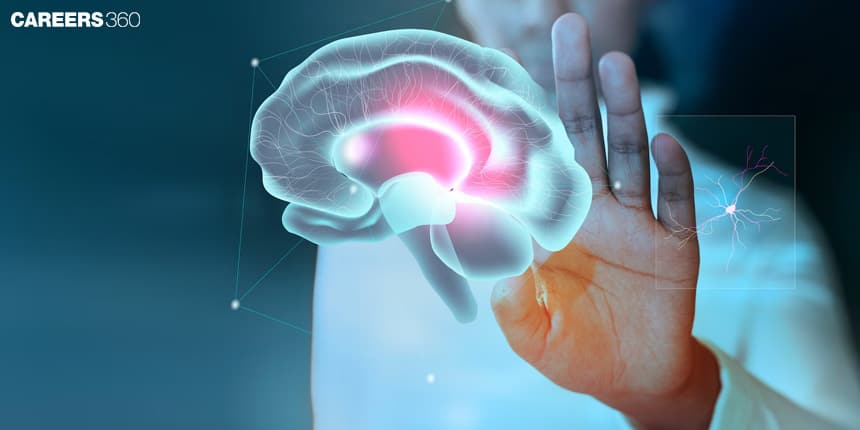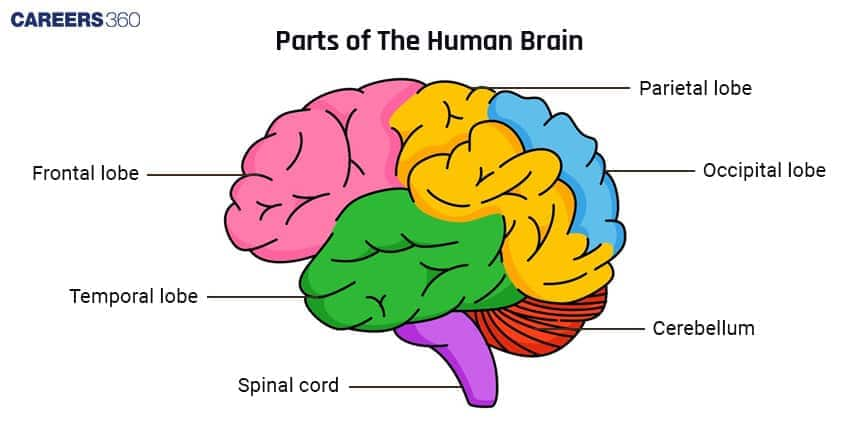Human Brain: Structure, Diagram, function, diagram, Facts, Functions, Anatomy
The human brain is the most complex central nervous system component that performs the control functions of thoughts, emotions, and actions. It closely relates to the spinal cord but differs in both structure and function. While the brain acts as the major processing site of sensory input, voluntary behaviour, and decision, the spinal cord acts mainly as a passageway. This difference in the functioning of the brain and the spinal cord shows the complementary ways that these two could work as central organs to establish appropriate communication and coordination leading to life processes, survival, and adaptation toward environmental changes. This is a very important topic in the Chapter Neural Control and Coordination in Biology.
This Story also Contains
- What is the Human Brain?
- Location of the Brain
- Parts of the Human Brain
- Neurons and Synapses
- Blood Supply
- Functions of the Brain

What is the Human Brain?
The human brain is the most exceptional organ in human beings. It governs each part of our body and minds, centring our thoughts, emotions, memory, and behaviours. The structure and functions of the brain are so compelling that when understood, we would get overwhelmed by the complexity and huge role it plays in our day-to-day living. Weighing about 1.0 to 1.5 kg, an adult human brain contains approximately 86 billion neurons. The brain, together with the spinal cord, forms part of the central nervous system that controls all activities in the human body, from mere thoughts and body movements to the interpretation of senses.
Also Read:
Location of the Brain
The brain sits in the skull, composed of 22 bones. It is cushioned by CSF, which also provides some immunological protection and suspends the brain to reduce its effective weight.
Parts of the Human Brain
The different parts of the human brain are:
Forebrain
The parts of the forebrain are:
Cerebrum: The largest part responsible for thinking, intelligence, consciousness, memory, and sensory interpretation.
Hypothalamus: Body temperature, emotions, hunger, sleep, synthesises some essential hormones
Thalamus: Relaying sensory and motor information
Midbrain
The parts of the midbrain are:
Tectum: Conducts sensory information from the ears and controls reflex movements
Tegmentum: Seems to be concerned with body movements, the process of sleep, arousal and attention
Hindbrain
The parts of the hindbrain are:
Cerebellum: Coordinates balance of the body and voluntary movements
Medulla Oblongata: Coordinates autonomic functions such as heartbeat and breathing
Pons: Acts as a bridge in conduction signals between different parts of the brain and controls sleep cycles and respiratory activities.
Diagram of Brain

Structure of the Brain
The human brain can be anatomically divided into three main parts: the forebrain, midbrain, and hindbrain.
Each part includes specific structures and functions essential in various physiological and psychological processes.

Neurons and Synapses
Neurons are the simplest functional units of the brain, transmitting information through electrical and chemical signals.
Synapses are interconnections between neurons, facilitating communication within the brain.
Blood Supply
The carotid and vertebral arteries supply blood to the brain.
The skull, meninges, and cerebrospinal fluid offer protection to the brain.
Functions of the Brain
The functions of the brain have been discussed below:
Cognitive Functions
The brain controls sensory processing, motor functions, cognition, emotions, and autonomic activities.
Different regions of the brain have specified functions.
Neuroplasticity
The brain can reorganise itself by forming new neural connections.
Neuroplasticity enables learning, memory, and recovery from brain injuries.
Important Points to Remember
The human brain weighs approximately 1.4 kilograms and contains approximately 86 billion neurons.
It takes up about 20 per cent of the energy of the whole body while it makes up only 2 per cent of the human body weight.
The left hemisphere of the brain controls the right side of the human body, and vice versa.
Also Read:
Recommended video on the Human Brain
Frequently Asked Questions (FAQs)
The human brain is divided into the forebrain, midbrain, and hindbrain.
Neurons are the simplest functional units of the brain and are responsible for transmitting information through electrical and chemical signals.
The skull, meninges, and cerebrospinal fluid protect the brain.
Neuroplasticity is when the brain reorganises itself to form new neural links; it's important in learning and memory and the recovery of function following injuries to the brain.
Brain energy consumption accounts for quite a huge portion of the body's energy, about 20%.